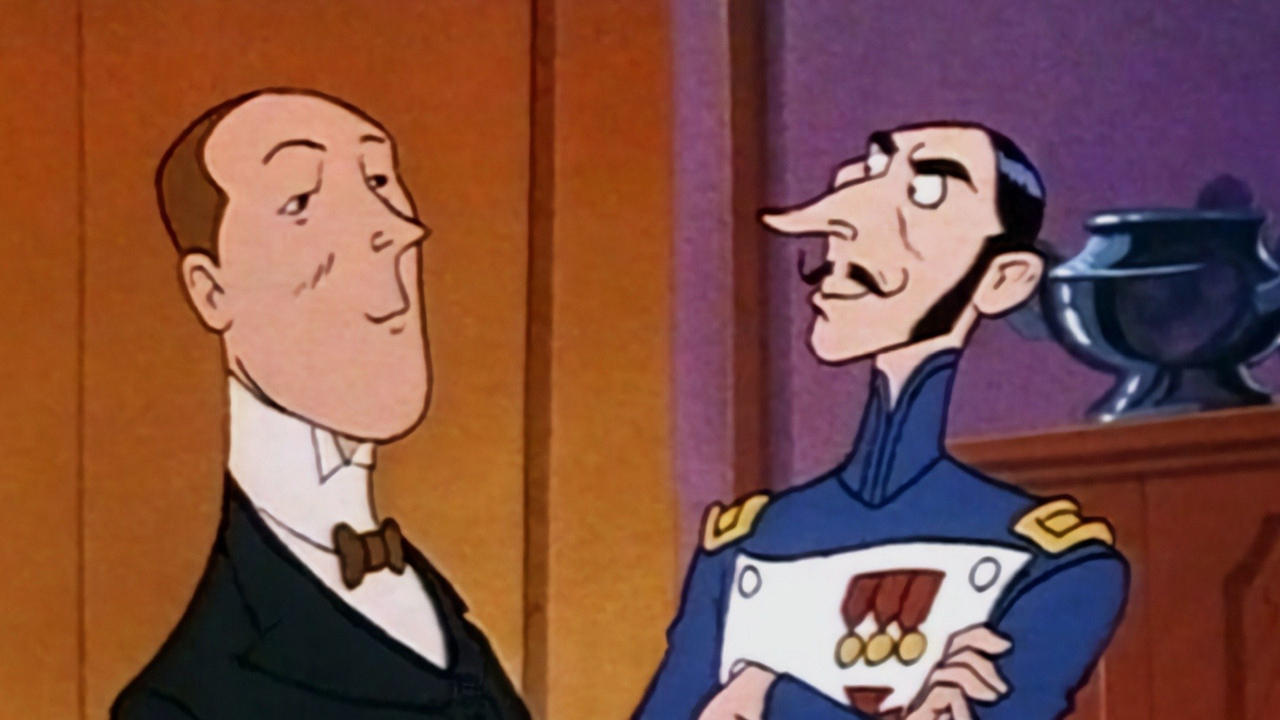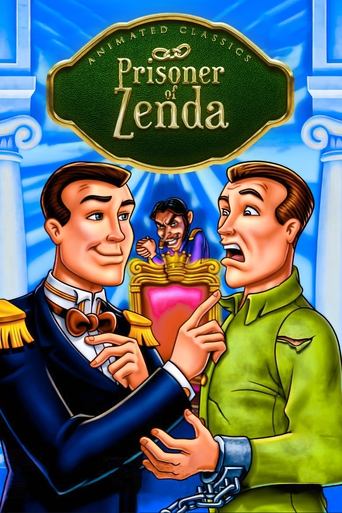SpuffyWeb
Sadly Over-hyped
Supelice
Dreadfully Boring
SparkMore
n my opinion it was a great movie with some interesting elements, even though having some plot holes and the ending probably was just too messy and crammed together, but still fun to watch and not your casual movie that is similar to all other ones.
Aneesa Wardle
The story, direction, characters, and writing/dialogue is akin to taking a tranquilizer shot to the neck, but everything else was so well done.
TheLittleSongbird
It is not as if I dislike Burbank Films Australia animations. On the contrary. While I was disappointed in this, The Odyssey, 20000 Leagues Under the Sea, Through the Looking Glass and The Three Musketeers, I did love Wind in the Willows, Peter Pan, Treasure Island, Around the World in Eighty Days and The Adventures of Robin Hood. For me, the only redeeming quality of this Prisoner of Zenda were the landscapes and background art, which were suitably colourful and beautifully realised on the whole. I can't say the same for the character designs though, which throughout are very crude. The characters themselves are not as likable or as complex as they are in the book, understandably as it is condensed to 50 minutes, but here we are not just talking about a slight change in character, we are talking about characters that are so watered down that they are just not interesting. When the most interesting character in the book, Rupert, is excised completely, you know there is something wrong, same with omitting the idea that the twins are in love with the same woman which actually misses the point of about half the story. The music is not terrible, nor is it anything remarkable. The writing suffers from over-simplification and lack of wit, while the story, which I always did find thrilling, feels dull and unexciting and the lack of sword-fights really do take away from the character and spirit of it. The voice acting was rather bland, with the villainous characters overdone and non-threatening. All in all, the landscapes are good but the rest didn't work for me. 2/10 Bethany Cox
D_Burke
I like independent animated movies that fall below the radar. That's not to say I don't appreciate Disney or other popular animation giants. However, there's something noble about animators who create a good story with intriguing characters on a smaller budget. Independent full-length animated features that don't conform to family-friendly standards are ones I admire the most.That's why it's hard not to respect "The Prisoner of Zenda", the first and only animated movie based on the 1892 novel by Anthony Hope. It doesn't try to be like Disney at all. It doesn't talk down to children, but also doesn't alienate adults by being too cute for its own good. That being said, it's hard to say who the intended audience is for this film. Would any child be interested in seeing this movie over other animated features that are out there?Burbank Films Australia released this movie in 1988. As far as I know, it wasn't released theatrically in America, and I'm not sure how well regarded it is in Australia or other parts of the world. I first discovered it on Nickelodeon one afternoon when I was 10. I remember liking it, or at least I could follow the story pretty well. The film came to my attention again recently when I purchased the DVD at a toy store for only 50 cents (in the clearance section). The DVD, manufactured in 1998, was so old that it was labeled a Digital Versatile Disc.Despite the age of the DVD, the picture and sound quality are actually good. There are times when it's difficult to tell what the characters are saying some of the time, but overall, the film was restored well.For a low-budget film, the animation was also pretty good. I liked the European feel of the background art, and the movements of the animated characters were fluid and not distracting in the slightest. I also admired how the lips moved in sync with the character's voices almost all of the time. It sounds patronizing, but truthfully, it matters when an independent studio is able to successfully make that effect happen. When it doesn't happen, the audience becomes distracted and taken out of the story.So by no means was the animated "Prisoner of Zenda" an easy film to make. It was 100% hand-drawn animation. Of course, for 70 years, that's all animation was, but it is still noteworthy.However, the question remains: was this story worth being an animated movie? That's where it gets tricky.This movie centers around the fictional European monarchy of Ruritania. The king, while on his death bed, appoints his son, modest and true Prince Rudolf, to succeed him. Rudolf has a fraternal twin brother, Prince Michael, who was technically born first. However, the king does not make him king because he has "wildness within (him) that is not befitting to a king". You learn as the movie progresses that Michael is tyrannical and that his father is essentially correct in not appointing him, but that reason could have been worded less vaguely.I confess that I haven't read the novel yet, and I try to read literature based on films before I go see them. However, I knew the novel had a better explanation for why Michael wasn't crowned king. According to Wikipedia, Michael was Rudolf's half brother in the book, and was born to a woman of non-royal blood whom the king married second, thereby making him less fit to be king than his brother. In the book and this movie, Michael can only become king if Rudolf dies.The story gets interesting when Michael immediately schemes to kill his brother. His wife, Princess Antionette (who, in the novel, is Michael's mistress), warns Rudolf immediately. Rudolf, although doubtful of his brother's desire to murder him, sends Antionette to London for reasons unexplained in this movie. They are merely brushed over by Rudolf saying, "Maybe I have a plan. Yes I do, but I'll need your help". The next scene cuts to London 3 weeks later (says the subtitles), and no further details are revealed.Antionette runs into a gentlemen named Rudolf Rassendyll, who looks identical to Prince Rudolf. The whole point of Antionette meeting him is that she spontaneously finds an effective double for Prince Rudolf, but it's doubtful Prince Rudolf knew about his existence, because Rudolf Rassendyll definitely didn't know about him.This and other details make this adaptation feel as though another more complex story is being held back. Furthermore, Prince Michael seems too cartoonishly menacing in this version. His henchmen are buffoons, which is not a bad thing. However, Michael seems too much of an idiot himself, and is more like Wile E. Coyote than Scar from "The Lion King" (1994). Scar and Prince Michael wished to take the throne by any means necessary, knowing their brothers' lives stood in the way. Scar was more menacing and smarter. In the end of this version, the consequences of Michael's actions are way too slapstick to be taken seriously. A lot of tension is also absent from the climax, and the ending was insipid.The filmmakers probably wanted to make this story appeal to kids, but either read the Cliff's Notes, or skipped over the racy details for family entertainment's sake. The animation is not half-baked, but the story sadly is. If anything positive should come out of this adaptation, it is that seeing it has made me want to read the book. If kids see this movie and somehow feel the same way, then it's impossible to dismiss this film as cheap animation.
DrMMGilchrist
This 1988 Australian animation, available on VHS and DVD, has to rank with the 1979 Peter Sellers version as a 'Prisoner of Zenda' too far. Under another title, it might just have passed muster as an animated comedy-adventure for a child with a low attention-span, but its relationship to the Hope novel is superficial. While some of the characters have the same names, they have been conflated or altered, and new, allegedly 'humorous' ones added.Trying hard to think of something positive to say, all I can think of is the fact that this is the only film version to date which has given us visibly red-haired Rudolfs, and audibly German-accented Ruritanians. On the other hand, the 1902 setting (the book came out in 1894, but, given the framing device in the sequel 'Rupert of Hentzau', the setting is probably c 1876) seems to have been chosen only to allow cars and *telephones* (which would have made the original plot fall apart, if you think about it...). The old King's widow is presented as the Queen (rather than his morganatic second wife), and his rival sons as non-identical twins. Rudolf V is depicted as the younger, more virtuous and more popular son - the direct opposite of the novel. Rassendyll, with an irritating comedy sidekick called Charlie, is recruited at a diplomatic ball in London by Antoinette, who is here referred to as a princess - which I'm sure she'd have loved! Rupert of Hentzau, one of the most memorable characters, has been excised completely.I kept wondering, what is the intended audience for this film? 'The Prisoner of Zenda' was not written for young children: it has only become relegated to the 'children's/young adult classics' bookshelf because of its lack of explicit sex and fairly moderate violence. Besides, from early childhood, I was captivated by the 1937 and 1952 talkie versions (also U-rated) on TV. A cartoon in which the landscapes are more appealing than the crudely-drawn characters (only the princesses have any charm), with no deaths (apart from old King Wilhelm at the beginning), no swordfights, and no tragically thwarted romances, would no more have appealed to me 30 years ago than it does now. Have children become so much less sophisticated?


